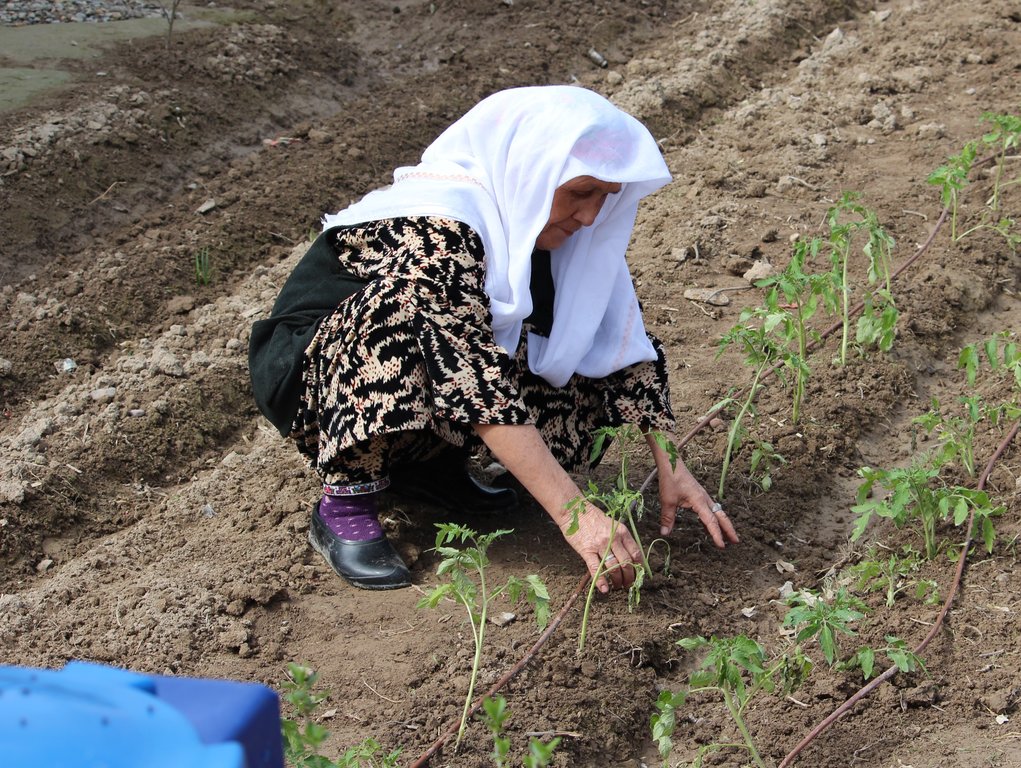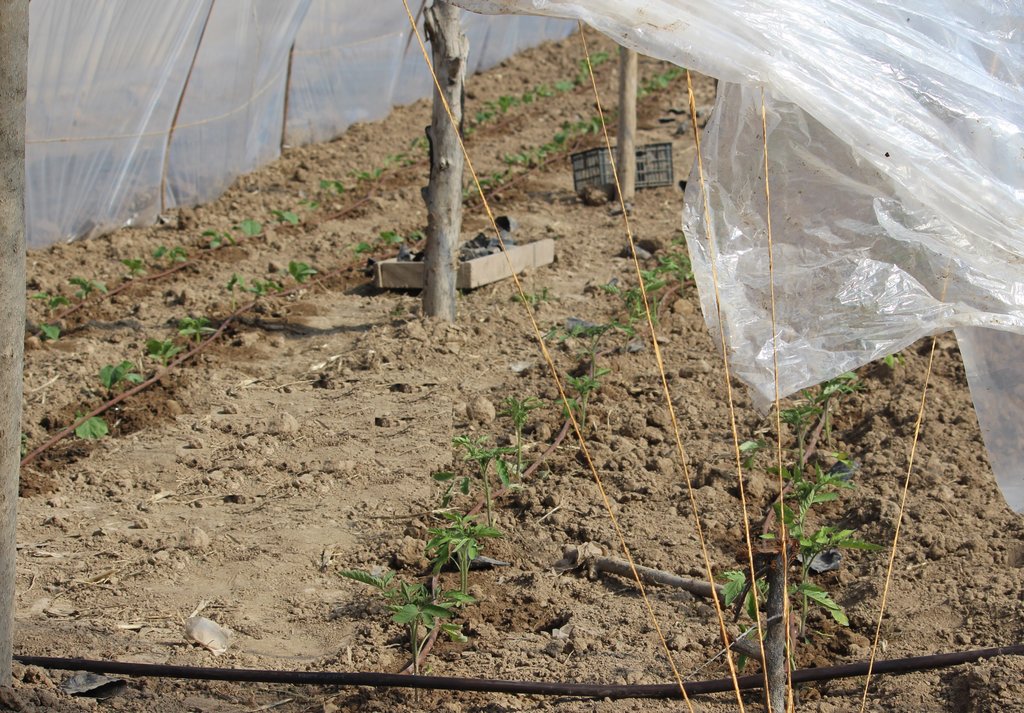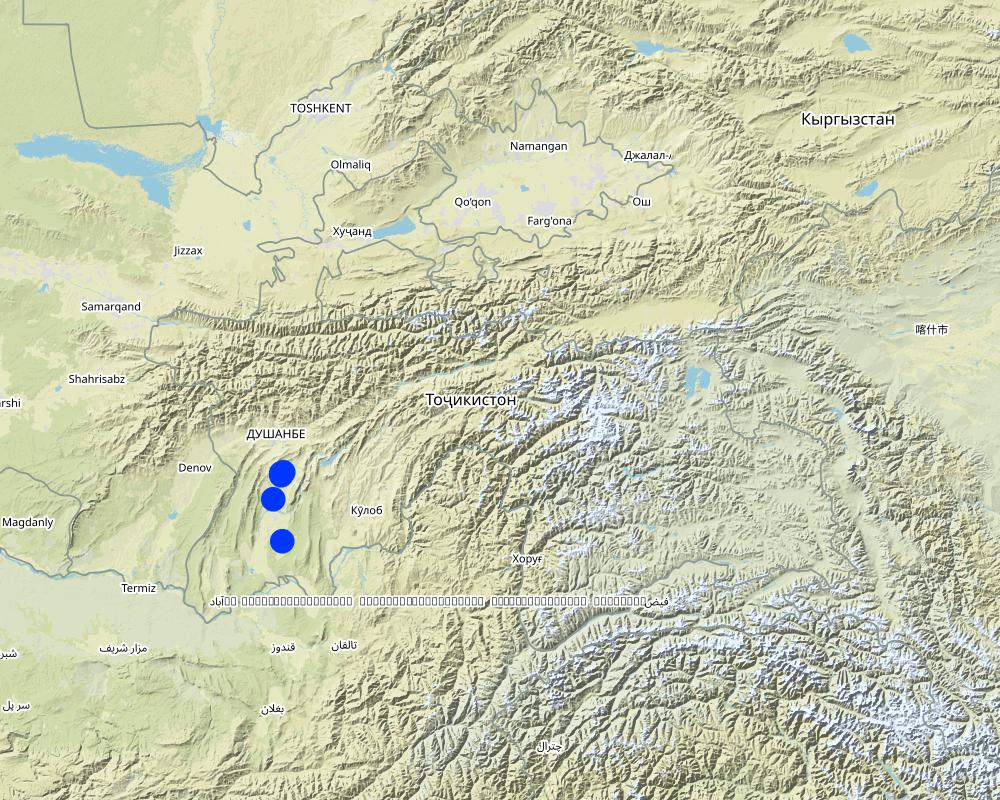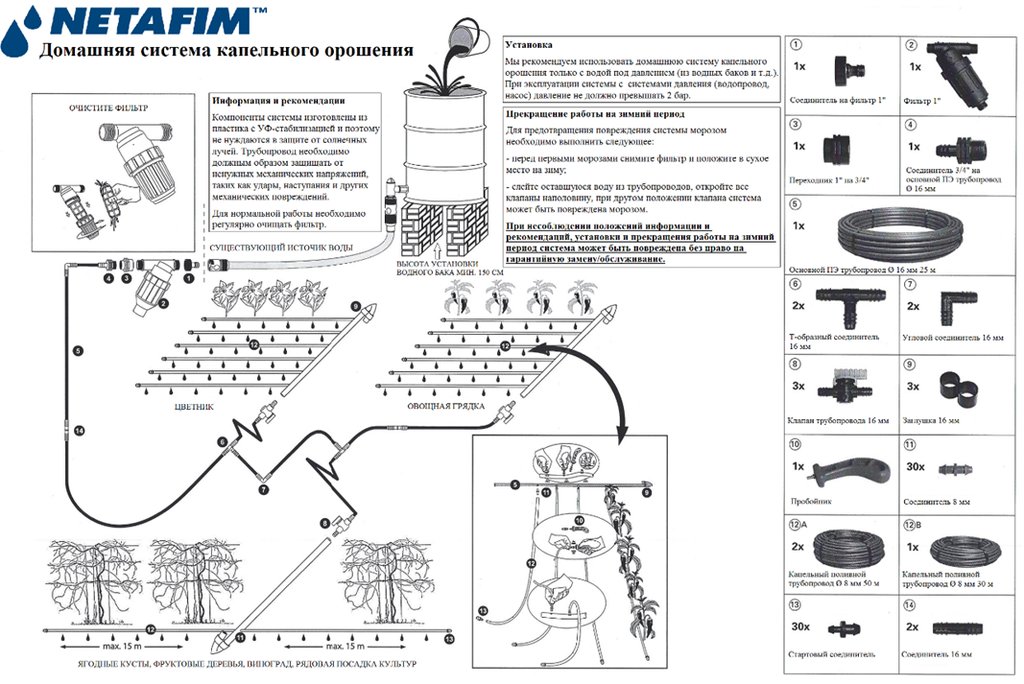Drip irrigation for kitchen gardens in dry areas [Tajikistan]
- Creation:
- Update:
- Compiler: Daler Domullodzhanov
- Editor: –
- Reviewers: William Critchley, Rima Mekdaschi Studer
Обёрии қатрагӣ дар заминҳои наздиҳавлигии минтақаҳои хушк
technologies_6164 - Tajikistan
View sections
Expand all Collapse all1. General information
1.2 Contact details of resource persons and institutions involved in the assessment and documentation of the Technology
Key resource person(s)
SLM specialist:
Tajikistan
Name of project which facilitated the documentation/ evaluation of the Technology (if relevant)
Central Asian Countries Initiative for Land Management (CACILM I)1.3 Conditions regarding the use of data documented through WOCAT
The compiler and key resource person(s) accept the conditions regarding the use of data documented through WOCAT:
Ja
1.4 Declaration on sustainability of the described Technology
Is the Technology described here problematic with regard to land degradation, so that it cannot be declared a sustainable land management technology?
Ja
2. Description of the SLM Technology
2.1 Short description of the Technology
Definition of the Technology:
Promotion of low-pressure drip irrigation kits among vulnerable women-led households in dry agrolandscapes of Southern Tajikistan has helped to fight desertification, improve food security and enhance economic opportunities.
2.2 Detailed description of the Technology
Description:
Low-pressure drip irrigation systems or Family Farm Drip Irrigation (FFDI) kits including water tanks and high-quality planting materials were distributed in the framework of an FAO project. The project aimed at enhancing food production by providing affordable irrigation solutions in dry and saline agrolandscapes of the Central Asian region. The FFDI systems were distributed to 60 women-led households in Khatlon province of Tajikistan. Additionally FFDI systems were installed in eight demonstration plots of organizations and state institutes. The beneficiaries were identified according to selection criteria to best contribute to food security and livelihood improvement through these affordable irrigation solutions. They were trained in irrigation and crop husbandry through a workshop, and their irrigation and plant production activities were monitored. Despite problems with pest management, vulnerable women-headed farms in the climate change affected areas increased crop productivity by 50% and harvested 2 crops a year. Vegetables were the crops of focus, and the average area irrigated was 300m2. Moreover, the application of the mulching helped to preserve more moisture and it helped to reduce irrigation norms by 25-30 per cent. For mulching, wheat straw and/or flax straw with a thickness of 7-10 cm was used. The FFDI system is affordable, does not require pumping, is easy to install and move, is easily adjustable and is supported by an installation kit. However, it does require relatively clean irrigation water. It is recommended to test expanded FFDI systems to continue the promotion of SLM and produce more food.
2.3 Photos of the Technology
2.5 Country/ region/ locations where the Technology has been applied and which are covered by this assessment
Country:
Tajikistan
Specify the spread of the Technology:
- applied at specific points/ concentrated on a small area
Is/are the technology site(s) located in a permanently protected area?
Nee
Map
×2.6 Date of implementation
If precise year is not known, indicate approximate date:
- less than 10 years ago (recently)
2.7 Introduction of the Technology
Specify how the Technology was introduced:
- during experiments/ research
- through projects/ external interventions
3. Classification of the SLM Technology
3.1 Main purpose(s) of the Technology
- improve production
- reduce, prevent, restore land degradation
- protect a watershed/ downstream areas – in combination with other Technologies
- preserve/ improve biodiversity
- adapt to climate change/ extremes and its impacts
3.2 Current land use type(s) where the Technology is applied
Land use mixed within the same land unit:
Ja
Specify mixed land use (crops/ grazing/ trees):
- Agroforestry

Cropland
- Annual cropping
Annual cropping - Specify crops:
- vegetables - leafy vegetables (salads, cabbage, spinach, other)
Number of growing seasons per year:
- 2
Specify:
vegetables, potato
Is crop rotation practiced?
Ja
3.3 Has land use changed due to the implementation of the Technology?
Has land use changed due to the implementation of the Technology?
- Yes (Please fill out the questions below with regard to the land use before implementation of the Technology)
Land use mixed within the same land unit:
Nee

Cropland
- Annual cropping
Annual cropping - Specify crops:
- vegetables - root vegetables (carrots, onions, beet, other)
3.4 Water supply
Water supply for the land on which the Technology is applied:
- mixed rainfed-irrigated
3.5 SLM group to which the Technology belongs
- water harvesting
- irrigation management (incl. water supply, drainage)
- home gardens
3.6 SLM measures comprising the Technology

agronomic measures
- A1: Vegetation/ soil cover
- A2: Organic matter/ soil fertility

structural measures
- S7: Water harvesting/ supply/ irrigation equipment

management measures
- M1: Change of land use type
3.7 Main types of land degradation addressed by the Technology

soil erosion by water
- Wt: loss of topsoil/ surface erosion

soil erosion by wind
- Et: loss of topsoil

biological degradation
- Bc: reduction of vegetation cover
3.8 Prevention, reduction, or restoration of land degradation
Specify the goal of the Technology with regard to land degradation:
- reduce land degradation
- restore/ rehabilitate severely degraded land
Comments:
The marginalized kitchen gardens plots were rehabilitated through the application of drip irrigation, intercropping, crop rotation, composting, mulching and better management of the plots.
4. Technical specifications, implementation activities, inputs, and costs
4.1 Technical drawing of the Technology
4.2 General information regarding the calculation of inputs and costs
Specify how costs and inputs were calculated:
- per Technology area
Indicate size and area unit:
300 m2
other/ national currency (specify):
TJS
If relevant, indicate exchange rate from USD to local currency (e.g. 1 USD = 79.9 Brazilian Real): 1 USD =:
9.2
Indicate average wage cost of hired labour per day:
100
4.3 Establishment activities
| Activity | Timing (season) | |
|---|---|---|
| 1. | Layouting of plot for drip irrigation system | |
| 2. | Levelling the ploughing, Harrowing | |
| 3. | Inter row cultivation | |
| 4. | Sowing | |
| 5. | Application of mulching | |
| 6. | Application of fertilizers | |
| 7. | Weeding, 3 times | |
| 8. | Harvesting (1 crop - 4 times tomato, 15-20 times cucumber) | |
| 9. | Instalment and dismantling of poles and cord for tomato, drip irrigation system | |
| 10. | Instalment and dismantling of, drip irrigation system |
4.4 Costs and inputs needed for establishment
| Specify input | Unit | Quantity | Costs per Unit | Total costs per input | % of costs borne by land users | |
|---|---|---|---|---|---|---|
| Labour | Operation and maintainence on kitchen garden | days | 20.0 | 100.0 | 2000.0 | |
| Equipment | Drip irrigation system including installation | set | 1.0 | 736.0 | 736.0 | |
| Equipment | Water tanks with transportation cost | set | 1.0 | 384.0 | 384.0 | |
| Plant material | Hybrid varieties of cucumber seeds or saplings | package | 1.0 | 230.0 | 230.0 | |
| Fertilizers and biocides | Organic fertilizer | kg | 90.0 | 1.0 | 90.0 | |
| Fertilizers and biocides | Mineral fertilizer (N, P) | kg | 12.0 | 7.0 | 84.0 | |
| Total costs for establishment of the Technology | 3524.0 | |||||
| Total costs for establishment of the Technology in USD | 383.04 | |||||
4.5 Maintenance/ recurrent activities
| Activity | Timing/ frequency | |
|---|---|---|
| 1. | Assembling and unmounting | twice per season |
4.6 Costs and inputs needed for maintenance/ recurrent activities (per year)
| Specify input | Unit | Quantity | Costs per Unit | Total costs per input | % of costs borne by land users | |
|---|---|---|---|---|---|---|
| Labour | Assembling and unmounting | times | 2.0 | 50.0 | 100.0 | |
| Total costs for maintenance of the Technology | 100.0 | |||||
| Total costs for maintenance of the Technology in USD | 10.87 | |||||
If land user bore less than 100% of costs, indicate who covered the remaining costs:
The 51% of the initial cost was covered by FAO
5. Natural and human environment
5.1 Climate
Annual rainfall
- < 250 mm
- 251-500 mm
- 501-750 mm
- 751-1,000 mm
- 1,001-1,500 mm
- 1,501-2,000 mm
- 2,001-3,000 mm
- 3,001-4,000 mm
- > 4,000 mm
Specify average annual rainfall (if known), in mm:
355.00
Agro-climatic zone
- arid
5.2 Topography
Slopes on average:
- flat (0-2%)
- gentle (3-5%)
- moderate (6-10%)
- rolling (11-15%)
- hilly (16-30%)
- steep (31-60%)
- very steep (>60%)
Landforms:
- plateau/plains
- ridges
- mountain slopes
- hill slopes
- footslopes
- valley floors
Altitudinal zone:
- 0-100 m a.s.l.
- 101-500 m a.s.l.
- 501-1,000 m a.s.l.
- 1,001-1,500 m a.s.l.
- 1,501-2,000 m a.s.l.
- 2,001-2,500 m a.s.l.
- 2,501-3,000 m a.s.l.
- 3,001-4,000 m a.s.l.
- > 4,000 m a.s.l.
Indicate if the Technology is specifically applied in:
- concave situations
5.3 Soils
Soil depth on average:
- very shallow (0-20 cm)
- shallow (21-50 cm)
- moderately deep (51-80 cm)
- deep (81-120 cm)
- very deep (> 120 cm)
Soil texture (topsoil):
- medium (loamy, silty)
Soil texture (> 20 cm below surface):
- medium (loamy, silty)
Topsoil organic matter:
- medium (1-3%)
5.4 Water availability and quality
Ground water table:
> 50 m
Availability of surface water:
poor/ none
Water quality (untreated):
poor drinking water (treatment required)
Water quality refers to:
surface water
Is water salinity a problem?
Nee
Is flooding of the area occurring?
Nee
5.5 Biodiversity
Species diversity:
- medium
Habitat diversity:
- medium
5.6 Characteristics of land users applying the Technology
Sedentary or nomadic:
- Semi-nomadic
Market orientation of production system:
- mixed (subsistence/ commercial)
Off-farm income:
- 10-50% of all income
Relative level of wealth:
- very poor
- poor
Individuals or groups:
- individual/ household
- groups/ community
Level of mechanization:
- manual work
- animal traction
Gender:
- women
Age of land users:
- youth
- middle-aged
5.7 Average area of land used by land users applying the Technology
- < 0.5 ha
- 0.5-1 ha
- 1-2 ha
- 2-5 ha
- 5-15 ha
- 15-50 ha
- 50-100 ha
- 100-500 ha
- 500-1,000 ha
- 1,000-10,000 ha
- > 10,000 ha
Is this considered small-, medium- or large-scale (referring to local context)?
- small-scale
5.8 Land ownership, land use rights, and water use rights
Land ownership:
- communal/ village
- individual, not titled
Are land use rights based on a traditional legal system?
Ja
5.9 Access to services and infrastructure
health:
- poor
- moderate
- good
education:
- poor
- moderate
- good
technical assistance:
- poor
- moderate
- good
employment (e.g. off-farm):
- poor
- moderate
- good
markets:
- poor
- moderate
- good
energy:
- poor
- moderate
- good
roads and transport:
- poor
- moderate
- good
drinking water and sanitation:
- poor
- moderate
- good
financial services:
- poor
- moderate
- good
6. Impacts and concluding statements
6.1 On-site impacts the Technology has shown
Socio-economic impacts
Production
crop production
Quantity before SLM:
0
Quantity after SLM:
60 t/ha
land management
Quantity before SLM:
nothing
Quantity after SLM:
well managed kitchen garden
Income and costs
farm income
Quantity before SLM:
0
Quantity after SLM:
60 t/ha
Comments/ specify:
The kitchen gardens were not productive at all, because of limited access to the water resources.
Socio-cultural impacts
SLM/ land degradation knowledge
Quantity before SLM:
very limited
Quantity after SLM:
improved
Comments/ specify:
if before rural women had limited knowledge of SLM and CSA techniques, now they started experimenting with different options of the techniques.
Ecological impacts
Soil
soil moisture
Quantity before SLM:
very limited, based on rain fall events
Quantity after SLM:
regulated
Comments/ specify:
The soil moisture was regulated to ensure the best condition to produce vegetables on the plots. The moisture storing capacity of the soil was improved, by enhancing the organic matter.
soil cover
Quantity before SLM:
bared
Quantity after SLM:
covered
Comments/ specify:
The soil was coved during the dry period of the year by biomass and the area between irrigation lines was covered by mulch to preserve soil moisture.
soil organic matter/ below ground C
Quantity before SLM:
low
Quantity after SLM:
encreased
Comments/ specify:
The application of organic matter has increased soil fertility and crops yield.
6.3 Exposure and sensitivity of the Technology to gradual climate change and climate-related extremes/ disasters (as perceived by land users)
Gradual climate change
Gradual climate change
| Season | increase or decrease | How does the Technology cope with it? | |
|---|---|---|---|
| seasonal temperature | summer | increase | very well |
6.4 Cost-benefit analysis
How do the benefits compare with the establishment costs (from land users’ perspective)?
Short-term returns:
positive
Long-term returns:
very positive
How do the benefits compare with the maintenance/ recurrent costs (from land users' perspective)?
Short-term returns:
positive
Long-term returns:
positive
6.5 Adoption of the Technology
- > 50%
Of all those who have adopted the Technology, how many did so spontaneously, i.e. without receiving any material incentives/ payments?
- 0-10%
6.6 Adaptation
Has the Technology been modified recently to adapt to changing conditions?
Ja
If yes, indicate to which changing conditions it was adapted:
- climatic change/ extremes
6.7 Strengths/ advantages/ opportunities of the Technology
| Strengths/ advantages/ opportunities in the land user’s view |
|---|
| The ToT training for promotors and best farmers on the topics of proper operation and maintenance of the drip irrigation systems were delivered to enable the active farmers from the different districts for continuing the promotion of the techniques. |
| The provided support of the project for most vulnerable families helped to increase family income and benefit from the crops yield increases and water is used with maximum efficiency, weeds cannot absorb water as it is not available for them. there are fewer weeds, soil infiltration capacity is increased, there is no soil erosion, applying water locally, leaching is reduced; fertilizer/nutrient loss is minimized. |
6.8 Weaknesses/ disadvantages/ risks of the Technology and ways of overcoming them
| Weaknesses/ disadvantages/ risks in the land user’s view | How can they be overcome? |
|---|---|
| Provision of the agriculture inputs for free can negatively affect the promotion of the best SLM techniques after the project life span. High investment costs can be one of the reasons for blocking upscaling. | To find a co-financing source and/or to increase co-financing ratio by the farmers. |
7. References and links
7.1 Methods/ sources of information
- interviews with SLM specialists/ experts
Data was provided by FAO specialist and beneficiaries.
When were the data compiled (in the field)?
09/10/2019
7.2 References to available publications
Title, author, year, ISBN:
Manual for farmers. Using Low-Pressure Drip Irrigation Systems to Irrigate Vegetables and Potatoes, Daler Domullodzhanov, 2012, ISBN 978-99947-913-2-3
7.3 Links to relevant online information
Title/ description:
article "Drip irrigation boosts water efficiency for Tajik farmers"
URL:
https://www.fao.org/europe/news/detail-news/en/c/1189380/
Links and modules
Expand all Collapse allLinks
No links
Modules
No modules






